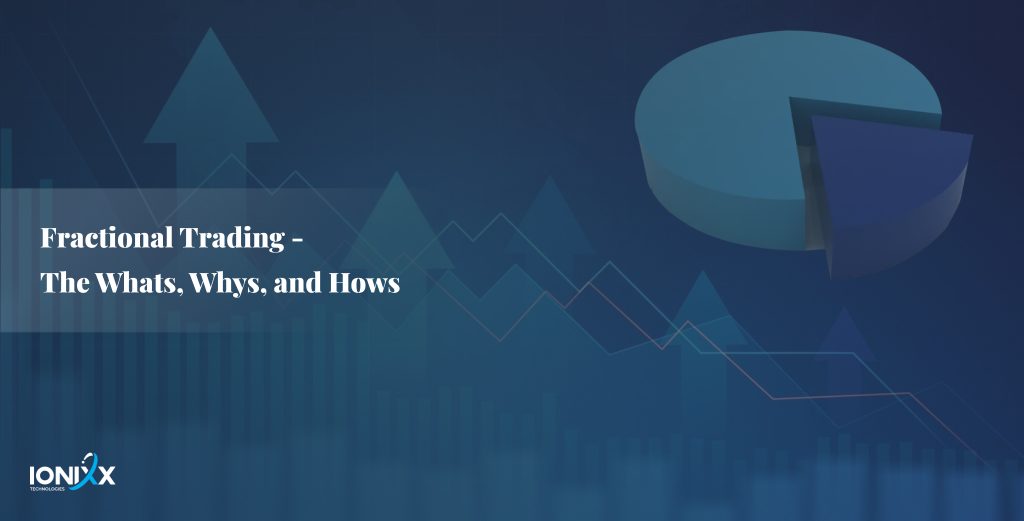
Let’s say a young investor wants to foray into buying stocks of tech mammoths such as Amazon and Apple that currently trades at $129 and $189 per share, respectively. If they are new to investing, they possibly do not have the funds to buy these stocks outright — and they probably do not want to advance that much into a single stock in one go. What would an investor do in such a situation?
Trade with fractional shares.
Offering the ability to buy fractions of pricey shares from as little as $5, fractional trading offers new investors who are constrained by minimum funds to build a robust yet diversified portfolio.
Tracing the Evolution of Fractional Trading
A December 2022 Forbes Advisor article reports that the average account size for a Robinhood investor was approximately $3,500 in 2021.
Interactive Brokers was the first major U.S. broker to announce fractional trade offerings on November 25, 2019. This was closely followed by Robinhood on December 12, 2019 and Fidelity on January 29, 2020. In June 2020, Charles Schwab joined the fractional trading bandwagon. Although Charles Schwab keeps its fractional trading services specific to S&P 500 stocks, the other three brokers offer comprehensive fractional trading services that cover a wide variety of stocks.
Eliminating barriers to purchasing high-priced stocks, retail investors with low capital reportedly take advantage of fractional trading to trade prominent stocks like FANG and Tesla, which tend to have a steep price tag.
All this is a clear indication that fractional trading not only helps new investors break the ice with investing in big names but also provides broker-dealers with a dramatic competitive edge.
Incorporating fractional trading into their offerings allows brokers to adapt to evolving investor expectations. With investors increasingly seeking accessible, personalized, and flexible investment options, being able to satisfy these requirements through fractional trading sets brokers apart from their competitors.
In this blog, we cover the following:
- Why is fractional trading important for retail investors?
- Keynote: Differentiation between brokers and broker-dealers
- How can brokers and broker-dealers support fractional orders?
- What kind of technology frameworks are needed?
- An OMS’s role in routing fractional orders
- What kind of securities can be traded fractionally?
- What is the typical trade execution style?
- What does the market look like without fractional trading?
- Sounding off – What do regulatory bodies and industry experts think of fractional trading?
- Key regulation points that brokers and broker-dealers need to consider for fractional trading
Fractional Trading for Retail investors
Democratizing investing
Ever since COVID-19 and the associated volume spikes in electronic trading, there has been a substantial increase in the number of retail investors investing in the capital markets. Since several of these retail investors may not have sufficient buying power readily available, fractional trading acts as a catalyst in enabling them to still enjoy the share of their favorite stock immediately, instead of waiting to save up the full amount to buy the one full share.
Diversified portfolio and freedom
Fractional trading also allows for a greater level of portfolio diversification and simplifies the experience of online trading application users. With fractional shares, retail investors can diversify down to the last penny, investing their money exactly where they want it. For automated investing, this diversification can help to lower risks while increasing profit potential over the long run.
Two sides of the coin – Benefits & Risks of Fractional Shares
Keynote Before We Dive In
Before we dive into the concepts of fractional trading, there is one key concept that we all need to be aware of.
Why are brokerage firms even called brokers or broker-dealers?
To take an example, a brokerage firm when only called a broker, is like your realtor when you are trying to buy a house from the market. The realtor here handles the duties of a broker, who does not really own the property but facilitates the buying or selling of it. Similarly, when a brokerage firm only handles the buying and selling of whole share orders, they are to be called brokers, because they only handle agent capacity orders (Orders that are bought or sold directly from the market without any proprietary account involved).
On the other hand, a brokerage firm may be called a broker-dealer, when an order is placed in a principal capacity. A principal capacity order happens when the firm buys the shares and holds them in its own inventory a.k.a proprietary account for a short period of time, and then sells it to investors/actual buyers. So the analogy we can use here is a car dealership that holds pre-owned cars in its inventory for a certain time and sells to the second or third owner.
Kinds of Trades Allowed To be Traded Fractionally
Brokerage firms generally offer several ways to buy or sell (order types) securities. However, some firms do not allow the use of certain order types to buy or sell fractional shares. For example, some firms only allow market orders for fractional share investing but will not allow limit orders.
Some brokerage firms only allow fractional share investing in stocks, while others allow it in stocks and exchange-traded funds (ETFs).
Typical Trade Execution Style for Fractional Trades
Some brokerage firms allow you to buy or sell fractional shares in real-time just like full shares. However, some brokerage firms aggregate orders to handle their customer’s buying and selling of fractional shares. Aggregating orders means rather than filling each fractional share order in real-time, the brokerage firm collects these orders throughout the day and then executes one or more large orders to fulfill them. The process your brokerage firm uses to handle the buying and selling of fractional shares may impact the price you pay or receive for a fractional share order.
When you own fractional shares, you will still receive dividends and participate in other corporate actions such as stock splits or reverse stock splits. Generally, you will participate in these corporate actions based on the percentage of a whole share that you own. For example, if you own .50 shares of ABC stock, and company ABC distributes a dividend of $5.00 per share, you would receive $2.50.
Liquidity of Fractional Shares
Liquidity refers to the ability to quickly and easily sell a stock or other security. If a stock in which an investor purchases fractional shares becomes illiquid, the underlying fractional shares will be illiquid as well. Some brokerage firms have indicated that they do not guarantee the liquidity of fractional shares, even if full shares of the stock are liquid. This means investors may have difficulty selling fractional shares in certain circumstances and could potentially lose money on the investment.
- As an investor, it is always recommended to ask your brokerage firm and read your brokerage firm’s account agreement to see if you need to consider liquidity when selling fractional shares.
- You generally cannot transfer fractional shares to another brokerage firm. If you decide to transfer your brokerage account to a different brokerage firm, you may have to sell any fractional shares in your account.
How Do Broker-Dealers Facilitate Fractional Trading?
Technology Frameworks
Fractional trading requires brokers and broker-dealers to adopt advanced technologies and frameworks to facilitate seamless trading experiences for their clients.
To ensure this broker-dealers are on the lookout for these high-end of the technology spectra OMSs that support fractional trading. Finding an OMS that supports fractional trading these days isn’t that of a complex search compared to 10 years ago. Furthermore, secure and scalable trading platforms are necessary to handle the increased volume and complexity of fractional trading. By investing in cutting-edge technology, brokers can provide their clients with fast and reliable fractional trading capabilities, giving them a distinct competitive edge in the market.
Using an OMS
Order management systems (OMS) play a crucial role in routing fractional orders efficiently. OMS platforms integrate with trading venues, allowing brokers to manage and execute orders seamlessly.
Most of the OMSs in the market that support fractional trading have a sub-core system that is the heart of a fractional trading system. For example, one of the leading trading platform provider firms in the US, Drivewealth, has a tech supporting fractional trading called the Fracker technology. So, this cub-core of a system residing in the main OMS has additional business logic and checks that are personalized to support fractional shares.
By leveraging the capabilities of OMS, brokerages ensure that fractional orders are executed in a timely manner, minimizing any potential delays or trade disruptions.
What Does The Market Look Like without Fractional Trading?
The absence of fractional trading would have significant consequences for both retail investors and the broader market. Without fractional trading, retail investors would be limited to purchasing whole shares, excluding them from the benefits of investing in high-priced securities. This lack of inclusivity could hinder their ability to build well-diversified portfolios, potentially limiting their access to long-term wealth accumulation opportunities.
Furthermore, without fractional trading, prestigious companies may predominantly be owned by institutional investors and affluent individuals, exacerbating inequality in the investment world.
Regulatory Bodies And Their View on Fractional Trading
Regulatory bodies and industry experts have offered varying perspectives on fractional trading. Some view it as a positive development, applauding its ability to promote financial inclusivity and empower retail investors. Others approach it with caution, emphasizing the need for proper regulation and investor protection. Regulatory bodies are beginning to recognize the significance of fractional trading and are considering implementing rules and guidelines to ensure its smooth operation.
By addressing concerns such as investor protection, market transparency, and fair trading practices, these regulatory measures can promote the sustainable use of fractional shares.
Key Regulation Points for Broker-dealers for Fractional Trading
Three major reporting regulations for broker-dealers in the market are
- Consolidated Audit Trail (CAT)
- Trade Reporting Facility (TRF), and
- Over-the-counter Trade Reporting Facility (ORF)
Any mismatch between these reporting standards can raise a flag with regulating authorities. The SEC and FINRA require broker-dealers to ensure regulatory compliance by reporting trades that involve both a whole-share and fractional-share quantity.
Final Thoughts
Fractional trading has emerged as a game-changer in the investment world, allowing retail investors to access the benefits of owning fractional shares of high-priced securities. This innovative approach has democratized investing, empowering individuals to build diverse portfolios tailored to their financial goals. Capable of handling increased volumes and order flow, we build robust OMS solutions that support the trading of fractional shares, particularly in the retail trading segment. As broker-dealers compete to offer it as a key differentiator, we at Ionixx, help build competent technology frameworks and OMS solutions that can help brokers and broker-dealers support the dynamic nature of fractional trading services. Speak to our experts today.


